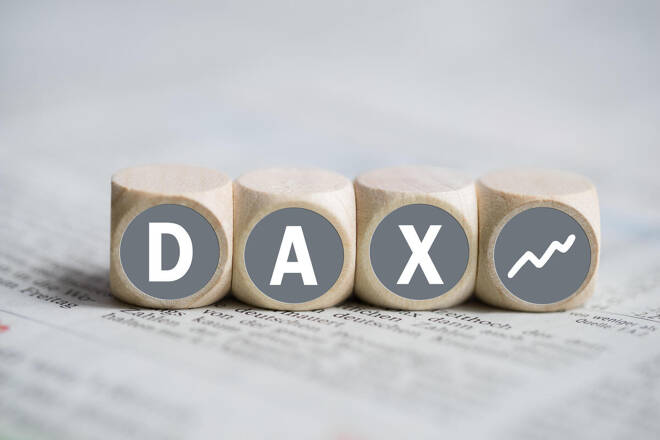Advertisement
Advertisement
DAX in the Hands of German PPIs and ECB President Lagarde
By:
After a bearish end to the week for the DAX, the futures point to a more positive start, supported by the news of UBS agreeing to acquire Credit Suisse Group.
It was a bearish Friday session for the DAX, which fell by 1.33% to end the day at 14,768.
Banking sector woes weighed on market risk sentiment despite the news of the Swiss central bank (SNB) stepping in to avert a Credit Suisse Group (AG) collapse and a banking sector crisis.
Economic indicators from the Eurozone and the US added to the bearish mood. The latest banking sector crisis has highlighted the broader impact of aggressive policy moves to tame inflation.
On Thursday, the ECB raised interest rates by 50 basis points despite the banking sector woes. The policy move raised fear of the further impact on the banking sector and the euro area economy.
Economic Indicators and Banking Sector Jitters Weigh
It was a busy day on the European economic calendar. Finalized Eurozone inflation figures and wages drew interest.
In February, the Eurozone annual inflation rate softened from 8.6% to 8.5%, unchanged from prelim figures. The core inflation rate accelerated from 5.3% to 5.6% in February.
While the inflation figures were unchanged from prelim figures, wages surged in Q4. Labor costs increased by 5.7% annually in Q4.
According to Eurostat,
- Wages & salaries per hour worked rose by 5.1% in Q4 compared with Q4 2021, while the non-wage component jumped by 7.7%.
- Wages & salaries per hour worked increased by 3.0% in Q3.
The wage growth figures weighed on the DAX ahead of the US session.
US consumer sentiment figures were also bearish. The Michigan Consumer Sentiment Index fell from 67.0 to 63.4 versus a forecasted 66.9. According to the prelim survey, the monthly decrease came ahead of the collapse of Silicon Valley Bank (SIVB) and Signature Bank (SBNY), suggesting the final numbers would reflect a more marked deterioration in sentiment.
The market reaction came despite the year-ahead inflation expectations component falling from 4.1% to 3.8%, its lowest since April 2021.
The Market Movers
It was a bearish Friday for the auto sector. Continental fell by 2.66 %, with Volkswagen ending the day with a 1.70% loss. Daimler and Porsche saw losses of 1.56% and 2.11%, respectively, with BMW declining by 0.96%.
Bank stocks also had a bearish session. Deutsche Bank and Commerzbank ended the day down 1.53 and 3.47%, respectively.
The Day Ahead for the DAX
It is a quiet day ahead on the economic calendar. German wholesale inflation figures will draw interest.
While the stats will provide direction, the banking sector will remain the focal point. A deepening crisis and news of more banks coming under pressure will weigh on riskier assets.
Later in the European session, euro area trade data will also provide direction.
There are no US economic indicators to influence, leaving ECB President Lagarde in focus. Comments relating to the banking sector crisis and possible influences on ECB monetary policy will provide direction.
DAX Technical Indicators
The DAX has to move through the 14,872 pivot to target the First Major Resistance Level (R1) at 15,049 and the Friday high of 15,153. A return to 15,000 would signal a bullish session. However, the DAX would need banking sector tensions to ease and euro area economic indicators to support a bullish session.
In the case of an extended rally, the bulls will likely test the Second Major Resistance Level (R2) at $15,331. The Third Major Resistance Level (R3) sits at 15,790.
Failure to move through the pivot would leave the First Major Support Level (S1) at 14,590 in play. However, barring another flight to safety, the DAX should avoid sub-$14,500 and the Second Major Support Level (S2) at 14,413. The Third Major Support Level (S3) sits at 13,954.
Looking at the EMAs and the 4-hourly chart, the EMAs send bearish signals. The DAX sits below the 200-day EMA (14,967). The 50-day EMA converged on the 100-day EMA, with the 100-day EMA narrowing to the 200-day EMA, delivering bearish signals.
A move through the 200-day EMA (14,967) would support a breakout from R1 (15,049) to give the bulls a run at 100-day (15,223) and 50-day (15,225) EMAs and R2 (15,331). However, failure to move through the 200-day EMA (14,967) would leave the Major Support Levels in play. A bearish cross of the 50-day EMA through the 100-day EMA would send a bearish signal.
The DAX Futures Sees Green
Looking at the futures markets, DAX was up 45 points, with the NASDAQ mini gaining 38.75 points. The Dow mini was up 77 points.
For a look at all of today’s economic events, check out our economic calendar.
About the Author
Bob Masonauthor
With over 28 years of experience in the financial industry, Bob has worked with various global rating agencies and multinational banks. Currently he is covering currencies, commodities, alternative asset classes and global equities, focusing mostly on European and Asian markets.
Advertisement
